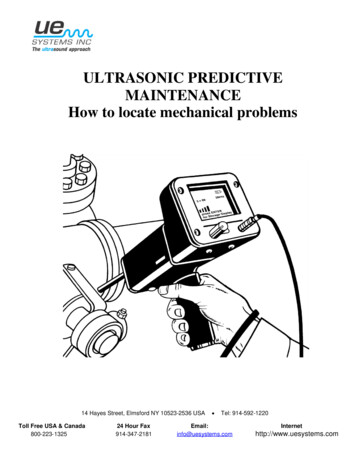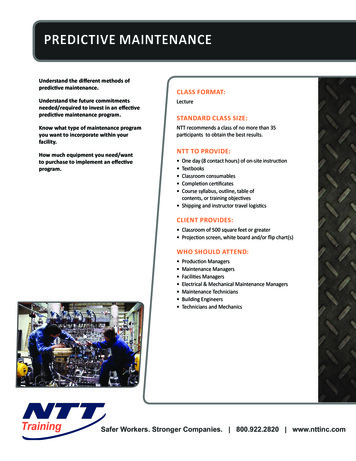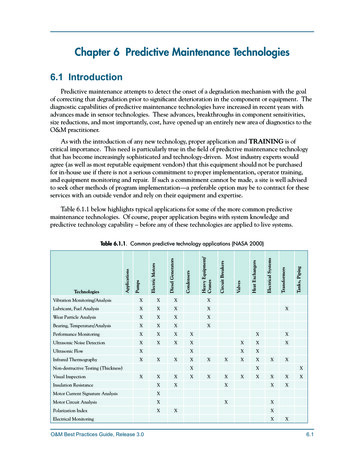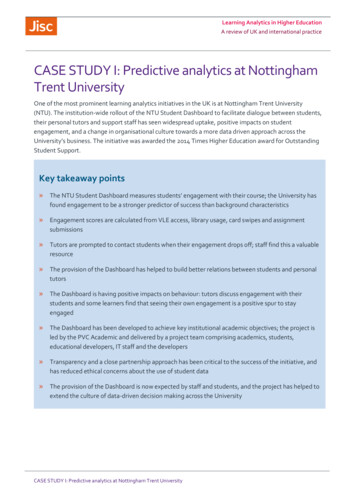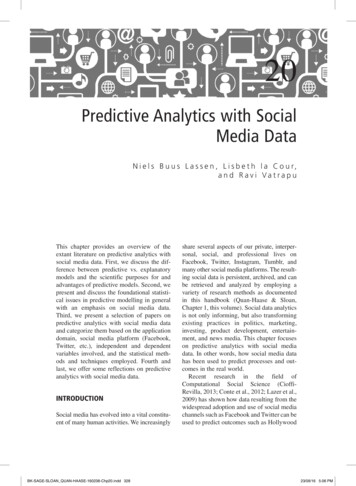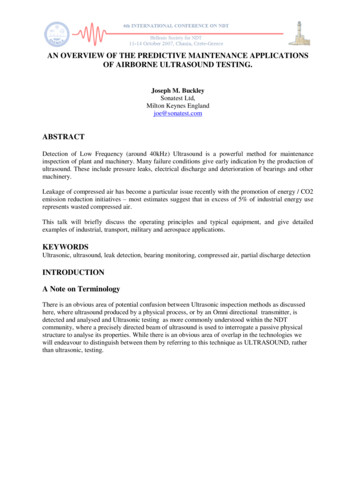
Transcription
AN OVERVIEW OF THE PREDICTIVE MAINTENANCE APPLICATIONSOF AIRBORNE ULTRASOUND TESTING.Joseph M. BuckleySonatest Ltd,Milton Keynes Englandjoe@sonatest.comABSTRACTDetection of Low Frequency (around 40kHz) Ultrasound is a powerful method for maintenanceinspection of plant and machinery. Many failure conditions give early indication by the production ofultrasound. These include pressure leaks, electrical discharge and deterioration of bearings and othermachinery.Leakage of compressed air has become a particular issue recently with the promotion of energy / CO2emission reduction initiatives – most estimates suggest that in excess of 5% of industrial energy userepresents wasted compressed air.This talk will briefly discuss the operating principles and typical equipment, and give detailedexamples of industrial, transport, military and aerospace applications.KEYWORDSUltrasonic, ultrasound, leak detection, bearing monitoring, compressed air, partial discharge detectionINTRODUCTIONA Note on TerminologyThere is an obvious area of potential confusion between Ultrasonic inspection methods as discussedhere, where ultrasound produced by a physical process, or by an Omni directional transmitter, isdetected and analysed and Ultrasonic testing as more commonly understood within the NDTcommunity, where a precisely directed beam of ultrasound is used to interrogate a passive physicalstructure to analyse its properties. While there is an obvious area of overlap in the technologies wewill endeavour to distinguish between them by referring to this technique as ULTRASOUND, ratherthan ultrasonic, testing.
Principles of OperationAs we are aware many physical „events‟ cause sound at audible frequencies, which can frequentlyindicate correct or incorrect operation, for example escaping air or steam, faulty bearings, impacts,friction, electrical discharges etc. etc. Similarly sound at Ultrasonic frequencies (in this context therange from around 20-100 kHz) is also produced. Ultrasound has many advantages for diagnosticpurposes:Typically ultrasound does not travel huge distances from its source, the attenuation rate in airis significantly higher.Ultrasound is more directional – it tends to travel from its source as a „cone‟Ultrasound disperses less, and in consequence does not tend to travel round corners.Ultrasound is easily shielded. Given appropriate sensors, airborne sources of ultrasound canbe located to within a few mm. With contact probes, sources of ultrasound within a metalstructure can often be localised to a few cm.Damage processes, such as bearing before, tend to produce detectable levels of ultrasoundlong before they are severe enough to be apparent audibly.Because of the short wavelength (40kHzcorresponds to 8mm wavelength in air atstandard Temperature and Pressure) It is easyto use highly directional sensing apparatus,allowing the direction of an ultrasound sourceto be determined to a degree or two.Therefore ultrasound can be used as an „earlierwarning‟ of fault processes and the source of theultrasound can be easily located.Typical EquipmentFigure 1: Ultrasound Detector with Parabolic ConcentratorThe Sonatest SoundScan 101 Receiver consists of:1. A sensitive high-frequency Microphone2. An adjustable amplifier3. Circuitry to “Down-convert” the ultrasound to audiblefrequencies4. An analogue meter allowing the ultrasound amplitude to bemeasured.All contained in a small hand held package powered by a 9VFigure 2: Sonatest SoundScan 101 Receiverbattery. Headphones are connected to allow identification of thesound source, and in many cases are preferable to the meter forassessment of problems – Typically there are many factors involved, rendering Quantitativemeasurements of limited validity.To match the instrument to the application a variety of sound guiding accessories are used. Typicallythese consist of Airborne ultrasound „concentrators‟ attached to the microphone to give an optimisedsound detection pattern, alternatively for detecting ultrasound transmitted within a structure, solid„contact probes‟ are used.
For localisation of sound in inaccessible areas a set of „acoustic probes‟ is used, These can be screwedtogether to reach approximately 1 metre. An Insulated probe is used when listening around electricalapparatus.Figure 4: Contact ProbesFigure 3: ConcentratorsFigure 5: Acoustic probe setOther manufacturer‟s equipment is broadly similar in principle. Particular variations include:1. The use of separate receiving transducers for different applications, which plug in directly orvia a cable.2. A greater emphasis of Quantitative Results. Opinions vary on this. Ours is that it can in mostapplications, lead to a false impression of precision. Others accept its limitations, but considerit extremely useful in defining acceptance criteria3. Some instruments have inbuilt data loggers or signal recorders. Typically this requires digitalcircuitry which imposes a significant increase in the power requirement. This impacts theweight, convenience and battery life.4. Variable frequency , This is seldom essential, since ultrasound generators are normallybroadband, however it can give advantages in certain applications, such as detectingunderground water leaks, where lower frequencies are attenuated less by concrete or earth.Enhancements to EquipmentCommonly used enhancements include:1. More sophisticated reflection and focussing systems, for example the Sonatest Powerbeam300 shown in figure 1 extends the range of the equipment by a factor of around 3 times, andreduces the angle of peak sensitivity to approximately 2 degrees. This allows distant noisesources such as overhead air leaks and electrical discharges (for example from defective highvoltage power line insulators) to be localised with great accuracy.2. A separate ultrasound transmitter for use in detecting „passive leaks‟ i.e. where no pressure ispresent, examples of this include enclosure seals, vehicle window seals, weld lines on tanks(quite small pinholes can be found), and marine cargo hatches.3. Data or signal logging equipment, allowing down-converted waveforms to be recorded andanalysed. This can be internal , PDA or PC based. Some systems record full waveforms,allowing detailed analysis others just amplitude points.
APPLICATIONSPressure Leak DetectionTurbulent flow of Gas through a small orifice will generate significant ultrasound allowing very smallleaks to be detected from quite a range –Airborne Ultrasound is the method of choice for detecting leaks in Steam, process gas, vacuum andparticularly compressed air systems.This has gained particular importance recently as companies strive to improve energy efficiency andreduce their CO2 emissions. Many governments are actively promoting the use of this equipment andsupporting it with tax incentives, as a wide variety of surveys in different countries(1)(2)(3) have foundCompressed air leak reduction to be one of the most cost effective energy conservation programs. –The „average‟ manufacturing company is reckoned to waste around 4% of its energy bill in leakedcompressed air. A regular survey using an ultrasonic leak detector allows leaks to be detected, taggedand prioritised for repair. As well as the environmental benefits the financial payback is very rapid,often a matter of a few months or even weeks.Leaks of other kinds of gas can be detected equally easily, Sound propagates both sides of the hole,and the principle is equally applicable to location of vacuum leaks- This equipment is used by NASAto find leaks to space in the Shuttle and International Space stations, Important from both a safety andan economic point of view - Air transported into orbit costs around 25,000 per kiloMonitoring of Bearing conditionAs ball or Roller bearings rotate the friction and impacts between the parts generate ultrasound.Normally operating bearings produce a steady level of ultrasound. If the bearings are under lubricatedthis becomes much louder and harsher. Conversely over lubricated (this can give rise to overheatingand rapid degradation of the lubricant) bearings make very little sound.Figure 6 : Properly Lubricated bearingFigure 7: Under-lubricated bearingFigure 8: Bearing with minor damage / grit ingreaseBearings which are beginning to fail typically have small particles of metal in the lubricant or havesmall surface irregularity
Electrical Discharge Detection.Most electrical discharges emit ultrasound which can be used to detect them. Examples include:Arcing at Loose / Poorly terminated connectionCorona discharge from high voltage connectionsPartial discharge from voids in insulators, or where air gaps exist between high voltageconnections [Because the dielectric strength of air is less than that of insulation materials suchas silicone rubbers, an air gap actually reduces the insulation strength]Tracking across high voltage insulatorsUltrasound allows these problems to be located:In industrial environments where background noise prevents sound being used to hear arcingIn bright lighting conditions which prevent visible indications. (Sparks)From a safe distanceWithout special access equipment especially using parabolic concentrators, which can detectultrasound from overhead power linesLiquid Flow MonitoringQuite small fluid flows passing through arestriction or bend can produce significantturbulence, generating enough ultrasound to beeasily detected. The example illustrated showsthe ultrasound levels measured with a contactprobe at a joint approximately 30cm from adomestic tap. The smallest stable flow from thetap (approx 0.1 l/minute) produces a signalapproximately 15dB higher than the noise level.Signals measured at the tap are far higher
Tightness TestingBy using an ultrasound Transmitter placed inside an enclosure which is „meant to be sealed‟ultrasound technology can find leaks where no inherent source of ultrasound is present.Examples of this include:Investigation of tank seals, both military and storage.Vehicle seals around windows etc.Checking for leaks in welded/ fabricated vesselsWaterproof enclosures for equipment or switchgearMarine Cargo hatchesShipping containersChecking of sealing around access points on bulkheads, for example where cable s pass fromone compartment of a ship to another.Other ApplicationsUltrasound can be used to listen to a wide range of equipment (4) in order to verify its correct functionor identify problems. Examples include:Steam trapsVehicle engines, listening to spark plugs, bearings, fuel injectors, valve operation, exhaustleaks etc.Gearboxes.Valves in industrial compressors.Location of hidden water leaksSwitchgear, for example you can listen to one of a row of industrial contactors.CONCLUSIONSUltrasound Testing is a very useful general purpose tool to have in the inspection box. From my ownpersonal view of having worked in NDT for over twenty year until I became aware of its fullcapabilities I was very surprised at the range and versatility of the technique. While many of the tasksare outside the traditional NDT field there is a considerable overlap, and it offers a straightforward andlow cost solution to a number of problems that I have previously encountered, and been unable tosolve.References1.2.3.4.The Carbon Trust on behalf of the Department of the Environment: Good Practice Guide 385:Energy Efficient Compressed Air SystemsAir and Mine Equipment Institute of Australia: Efficient Compressed Air Systems: How to saveEnergy, reduce costs and help the environmentU.S. Department of Energy: Improving Compressed Air System performance - a sourcebook forIndustryBenjamin Fried: More Than Just a Leak Detector, Plantservices.com, May 2006
AN OVERVIEW OF THE PREDICTIVE MAINTENANCE APPLICATIONS OF AIRBORNE ULTRASOUND TESTING. Joseph M. Buckley Sonatest Ltd, Milton Keynes England joe@sonatest.com ABSTRACT Detection of Low Frequency (around 40kHz) Ultrasound is a powerful method for maintenance inspection of plant and machinery. Many failure conditions give early indication by the



